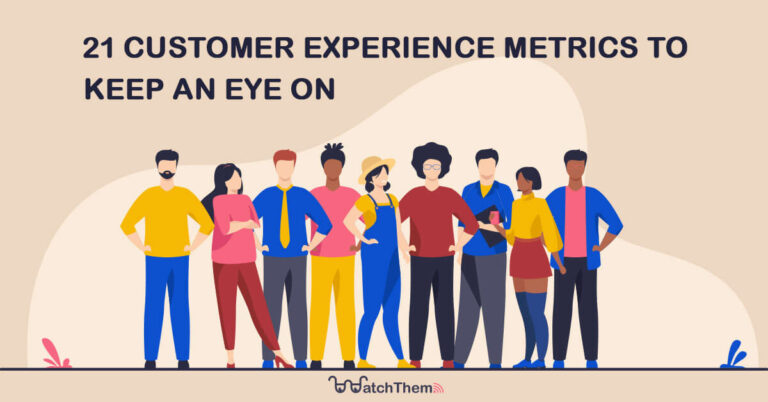Page Contents
Tracking customer experience has turned into an inevitable part of every business. If a business craves to generate more revenue (which they should!), they must know how people use their product. They have to figure out how people interact with it and how they feel about their experience. To track customer experience, business owners can use customer experience software. These tools help them measure customer experience metrics that matter.
This article will discuss customer experience and its metrics in depth. Read this article to find out more!
What is customer experience?
Customer Experience (CX) is the sum of the experiences users have when they interact with your product. CX includes in itself many subtopics, such as UX, UI, etc. You can track CX by measuring customer experience metrics.
Tracking CX is for all businesses, even enterprise businesses. Moreover, resourceful, deep connections help you obtain customers’ satisfaction and trust. However, the repercussion of low-quality impressions is that you will feed your competitors.
As a result, companies that tried to refine and enhance their CX encountered fantastic results: a 79% save in costs, an 84% increase in revenue, and a 92% growth in customer loyalty.
Related Article: Customer Experience Design [An Eye-Opening Guide]
What are the customer experience metrics?
Many customer experience metrics help you have a more vivid understanding of your CX and your business in general. However, you mostly will not need all of them. Some of them are of more excellent value when you want to have a clearer vision and general insight into your business.
Additionally, we categorized these customer experience metrics based on the stage we are in. Interaction metrics show what happens during customer experiences. Perception metrics measure what customers feel about their experience. Lastly, outcome metrics analyze what customers do as the result of their experience.
-
Interaction Metrics


1. Customer Effort Score (CES)
Another item in our list of customer experience metrics is CES. CES is a measurement of how much effort a customer has to put in to resolve their issue when interacting with your product. CES helps businesses figure out customer friction points and refine them to offer a more seamless experience. It is measured by asking customers how much work they had to do on a very low to very high scale.
2. First Contact Resolution (FCR)
FCR is one of the most critical customer experience metrics you should focus on. You can see how much efficiency you are providing to your customers. It represents the rate of the customers who have their problems resolved or questions answered against all the company’s calls.
3. Average Time Resolution (ATR)
ATR measures the sum of the time it takes to resolve a problem fully since the customer brought it up. A lower ATR makes the customers happier; therefore, it improves the customer experience. You can calculate the ATR by dividing the total of all the resolution times by the number of cases solved in a specific time period.
4. Customer Engagement
Making purchases is different from being engaged with a brand. The frequency of your customers’ communication with you, the time they spend on your site, and the number of their clicks make for strong customer engagement.
5. Customer Retention
Customer retention is one other customer experience metric you should be tracking. This metric is a representation of the number of customers who come back for another purchase. Resourceful customer experience often incentivizes the customers to return for a second purchase. This can often lower overall costs.
6. Customer Support Ticket Trends
Another item in our customer experience metrics list you need to care for is customer support ticket trends. Interpreting this metric can help you learn more about your CX. You can figure the pain points in your customer experience and fix them. Additionally, you can make your products more straightforward to use.
7. Visitor Intent
Visitor intent is one of the most vital customer experience metrics to track. Consumer psychology plays an essential role in finding out the reason customers come to a business website. You can also provide your customers with multiple options, asking them their primary focus of the visit. You can then optimize your conversion rate by improving your website.


With WatchThemLive’s session recording, feel as if you are in the mind of your customers. Easily see why your users are visiting your website and what they are doing on it. Sign up for FREE to optimize your business and generate revenue.
8. Task Completion
Task completion works hand-in-hand with visitor intent. It measures if customers succeeded in accomplishing what they wanted on the website. This item on our list of customer experience metrics splits successful and unsuccessful visits. You can measure it by asking a simple yes/no survey question.
9. Customer Acquisition
This customer experience metric simply measures the cost of getting a new customer. Marketing, customer experience, and data are all parts of this. Businesses aim for lower customer acquisition costs without losing potential customers. Having a resourceful customer experience and getting customers from referrals and reputation helps brands lower customer acquisition costs.
10. Contact Volume by Channel
Contact volume by channel helps brands pay attention to the ways their customers choose to interact with them. This metric tracks the number of questions and issues brought up through different channels. These channels include phones, email, chatbots, social media, etc. Tracking contact volume by channel helps companies have a deeper understanding of their customers. Moreover, companies can allocate resources and contact agents to the channels that need them in busy times more precisely.
11. Stock Price
Customers, as well as many others, are major stakeholders of companies. Stock price projects future growth and revenue. Companies with resourceful customer experience will tend to be primed for more enhancement and will have an increasing stock price.
-
Perception Metrics


1. Employee Engagement
A Gartner survey found out that employee engagement was a difference-making concern in CX enhancements. This CX metric tracks the extent to which employees feel passionate about their jobs. It drives performance more than other factors. It indicates the commitment to the organization and the honest, deep work and effort employees put into their work.
2. Employee Satisfaction
Employee satisfaction is another factor you should take into account after employee engagement. Satisfied employees create a strong customer experience. Employees with more satisfaction offer better customer service. Simply ask your employees how pleased they are with their jobs on a scale of 1 to 10.
3. Customer Loyalty
The loyalty of customers is a must-to-measure customer experience metric. You can track customer loyalty by measuring the frequency of purchases from customers. The more they regularly purchase, the more loyal they are. Loyal customers can be fantastic advocates for your company.
4. Customer Satisfaction (CSAT)
CSAT is another important cx metric you need to keep an eye on. It is a measurement of the customers’ average satisfaction score. CSAT often measures the satisfaction score of particular interactions, mostly right after it happens.
-
Outcome Metrics


1. Net Promoter Score (NPS)
NPS is one of the most important customer experience metrics you should be tracking. NPS represents the percentage of customers who would suggest your product/company to the people they know. It is simple to obtain it, and it is a pretty precise metric to track. You simply need to ask your customers a question. Ask how likely they are to recommend your product to their acquaintances on a scale of 1 to 10.
2. Churn Rate
Churn rate is a CX metric that tells you the number of customers who stopped doing business with your company over a particular period of time. It is the opposite of the retention rate. Customers will not leave if they have a fantastic experience, will they? Divide the lost customers by the total customers of a specific timeframe to measure the churn rate.
3. Referral Rate
The referral rate is an added step to NPS. This metric measures if customers do actually refer you to family and friends. We can measure this metric in many ways, such as creating referral programs with unique links for each customer. Additionally, we can use social listening.
4. Cart Abandonment Rate (CAR)
When trying to improve your customer experience, you should pay special attention to the CAR metric. High CAR can be a sign of a suboptimal online experience. Loyal customers do not fill their carts and leave them behind!
Related Article: Why is shopping cart abandonment a problem for retailers?
5. Social Mentions
Tracking this essential customer experience metric will give you an insight into people talking about you on social media. You can track the frequency, the opinions, and a lot more. You can then proceed to amend the relationships if needs be.
6. Customer Lifetime Value (CLV)
CLV represents the value of a customer to the business over their lifetime. It denotes how much a brand is gaining from its investments in marketing.
Conclusion
No matter which one of these you go after first, you must definitely track your customer experience metrics. Customer experience is what can help you escalate or ruin your business. Analyze it, and use WatchThemLive to provide your customers with the best experience of their lives.

